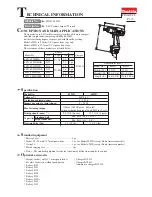
2
SafetyRecommendations
hose of accumulated dust and moisture. Before removing a tool from
service or changing sockets, make sure the air line is shut off and
drained of air. This will prevent the tool from operating if the throttle
is accidently engaged.
Never use the air hose for supporting, lifting, or lowering the tool. Use
a safety line or cable on the tool when working in elevated areas.
Tools with exposed throttles should not be used where obstructions
can hold the throttle in the “on” position. An impact wrench operating
in reverse will move backwards as a nut is removed and can trap an
operator's hand, making it difficult to release an outside trigger.
Inside trigger or pistol grip tools are advised for close quarter
operation.
Only use sockets designed for use with impact wrenches. Never use
a hand tool socket on an impact wrench. Hand tool sockets can
break, resulting in a hazard from flying pieces. Inspect sockets,
retainers, and drives regularly for wear or damage, and replace as
necessary. Worn sockets reduce power, cause drive wear, and
increase the chance for breakage and should not be used.
Some individuals may be susceptible to disorders of the hands and
arms when performing tasks consisting of highly repetitive motions
and/or exposure to extended vibration. Cumulative trauma disorders
such as carpal tunnel syndrome and tendonitis may be caused or
aggravated by repetitious, forceful exertions of the hands and arms.
Vibration may contribute to a condition called Raynaud's Syndrome.
These disorders develop gradually over periods of weeks, months,
and years. It is presently unknown to what extent exposure to
vibrations or repetitive motions may contribute to the disorders.
Hereditary factors, vascular or circulatory problems, exposure to
cold and dampness, diet, smoking and work practices are thought to
contribute to the conditions.
For your safety and the safety of others, read and understand the
safety recommendations before operating an impact wrench.
Always wear protective equipment and clothing.
For additional infor-
mation on eye pro-
tection, refer to Fed-
eral OSHA Regula-
tions, 29 CFR, Sec-
tion 1910.133, Eye
and Face Protection,
and ANSI Z87.1, Occupational and Educational Eye and Face
Protection. This standard is available from the American National
Standards Institute, Inc., 11 West 42nd Street, New York, NY 10036.
Hearing protection is
recommended in
high noise areas
(above 85 dBA).
Close proximity of
additional tools, re-
flective surfaces,
process noises, and resonant structures can substantially contrib-
ute to the sound level experienced by the operator. Proper hearing
conservation measures, including annual audiograms and training
in the use and fit of hearing protection devices may be necessary.
For additional information on hearing protection, refer to Federal
OSHA Regulations, 29 CFR, Section 1910.95, Occupational Noise
Exposure, and American National Standards Institute, ANSI S12.6,
Hearing Protectors.
• Gloves and other protective clothing should be worn as
required, unless they create a greater hazard.
• Do not wear loose fitting clothing, or clothing that may
restrict movement, become entangled or in any way
interfere with the safe operation of the impact.
Cleco impact wrenches are designed to operate on 90 psig (6.2 bar)
maximum air pressure. If the tool is properly sized and applied,
higher air pressure is unnecessary. Excessive air pressure in-
creases the loads and stresses on the tool parts, sockets, and
fasteners and may result in breakage. Installation of a filter-regula-
tor-lubricator in the air supply line ahead of the tool is highly
recommended.
Before the tool is connected to the air supply, check the throttle for
proper operation (i.e., throttle moves freely and returns to closed
position). Being careful not endanger adjacent personnel, clear air
Repetitive work motions and/or vibration
may cause injury to hands and arms.
Use minimum hand grip force consistent
with proper control and safe operation.
Keep body and hands warm and dry.
Avoid anything that inhibits blood circulation.
Avoid continuous vibration exposure.
Keep wrists straight.
WARNING
!
Avoid repeated bending of wrists and hands.
CAUTION
!
Personal hearing protection is
recommended when operating
or working near this tool.
WARNING
!
Impact resistant eye protection
must be worn while operating
or working near this tool.



















